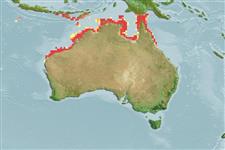>
Eupercaria/misc (Various families in series Eupercaria) >
Haemulidae (Grunts) > Plectorhinchinae
Etymology: Plectorhinchus: Greek, plektos = plaited + Greek, rhyngchos = snout (Ref. 45335); caeruleonothus: Name from the Latin words 'caeruleo' for blue and 'nothus' for bastard when combined as ‘Blue Bastard’ which has been commonly applied to this species by anglers for many years; referring to its blue sheen in life and difficulty to hook and land on artificial fly..
Environment: milieu / climate zone / depth range / distribution range
экология
морской ассоциированный с рифами; пределы глубины 6 - 30 m (Ref. 103290). Tropical; 9°S - 25°S, 101°E - 147°E (Ref. 103290)
распространение
страны | регионы FAO | Ecosystems | места находок | Point map | интродукции | Faunafri
Southwest Pacific: Australia (Western Australia toi Queensland).
Size / Вес / Возраст
Maturity: Lm ? range ? - ? cm
Max length : 100.0 cm TL самец/пол неопределен; (Ref. 103290)
Краткое описание
морфология | морфометрия
колючие лучи спинного плавника (общее число): 12; членистые (мягкие) лучи спинного плавника (общее число): 18-20; колючие лучи анального плавника 3; членистые (мягкие) лучи анального плавника: 6 - 7. This species is distinguished by the following features: D XII, 18-20 (rarely 20); A III, 6-7 (rarely III, 6); pectoral-fin rays 16-17 (usually 17); lateral-line scales 56-61 (modally 59); transverse scale rows above lateral line 15; gill rakers 7-9 + 18-20 = 25-29 (modally 26); in juveniles, pelvic fins reaching anus, slightly short of anus in adults; nostrils minute, 0.4-0.8 % SL, 2-3 times in distance from posterior nostril to eye; when fresh colouration in adults with body uniformly silver-grey, cheek and opercles blue-grey, rim of orbit and dorsal edge of maxilla dusky yellow, posterior margin of opercular membrane silver-grey, non-contrasting with remainder of opercle and adjacent body (Ref. 103290).
This species is found on sand, rubble and reef bottom but mostly in the intertidal zone, or shallow reef; one specimen trawled in a depth of 30 m. The most southerly record is a large individual estimated to be 100 cm in total length. Large individuals are most often solitary, foraging diurnally over relatively open expanses of soft substrate. Agonistic behavioural interactions have been recorded between individuals, individuals have often been observed to interact highly aggressively, engaging in one-on-one conflicts (Ref. 103290).
Life cycle and mating behavior
половая зрелость | размножение | нерест | икра | Fecundity | личинки
Johnson, J.W. and J.W. Wilmer, 2015. Plectorhinchus caeruleonothus, a new species of sweetlips (Perciformes: Haemulidae) from northern Australia and the resurrection of P. unicolor (Macleay, 1883), a species previously confused with P. schotaf (Forsskål, 1775). Zootaxa 3985(4):491-522. (Ref. 103290)
Статус Красного Списка МСОП (Ref. 130435)
Угроза для людей
Harmless
Использование человеком
дополнительная информация
странырегионы FAOEcosystemsместа находокинтродукцииStocksэкологияпищапищевые объектыпотребление пищирацион
народные названиясинонимыобмен веществхищникиэкотоксикологияразмножениеполовая зрелостьнерестSpawning aggregationFecundityикраРазвитие икры
Возраст/РазмерыростЗависимость между длиной и массой телаЗависимость между длинамиРазмерный составморфометрияморфологияличинкидинамика численности личинокпополнениечисленностьBRUVS
ссылкиаквакультура (рыбоводство)особенности рыбоводствастепень растяжениягенетикаElectrophoresesнаследуемостьболезниобработкаNutrientsMass conversion
соавторыизображенияStamps, Coins Misc.звукиCiguateraскоростьтип плаванияжаберная областьOtolithsмозгзрение
инструменты
Специальные отчеты
Скачать в формате XML
ресурсы в Интернет
Estimates based on models
Phylogenetic diversity index (Ref.
82804): PD
50 = 0.5000 [Uniqueness, from 0.5 = low to 2.0 = high].
Bayesian length-weight: a=0.01380 (0.00670 - 0.02842), b=3.00 (2.83 - 3.17), in cm total length, based on LWR estimates for this Genus-body shape (Ref.
93245).
Trophic level (Ref.
69278): 3.9 ±0.6 se; based on size and trophs of closest relatives
устойчивость к внешним воздействиям (Ref.
120179): очень низкий, минимальное время удвоения популяции более 14 лет (Preliminary K or Fecundity.).
Fishing Vulnerability (Ref.
59153): High vulnerability (60 of 100).
Nutrients (Ref.
124155): Calcium = 21.8 [8.7, 40.3] mg/100g; Iron = 0.445 [0.233, 0.856] mg/100g; Protein = 19.4 [17.5, 21.3] %; Omega3 = 0.106 [0.058, 0.178] g/100g; Selenium = 36.5 [20.4, 62.3] μg/100g; VitaminA = 57.3 [21.5, 147.8] μg/100g; Zinc = 0.964 [0.681, 1.396] mg/100g (wet weight);
